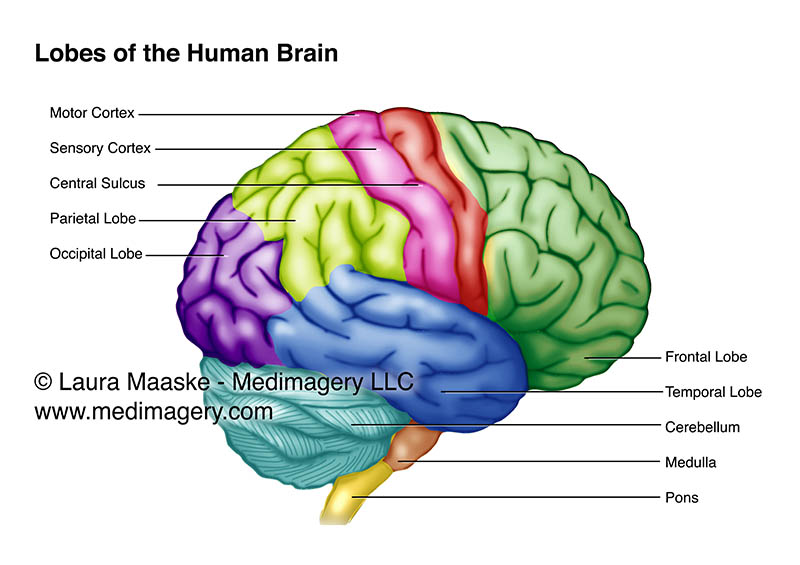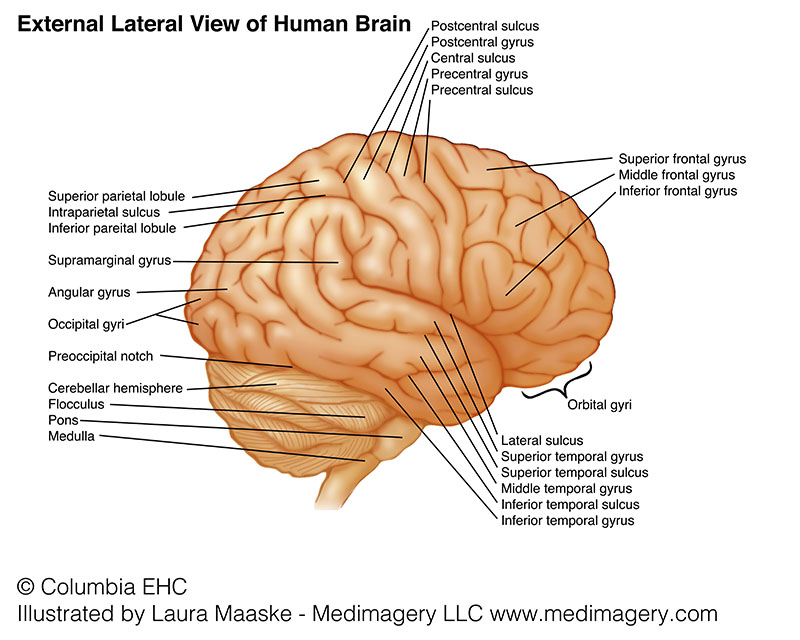
Brain Anatomy & Illustration | Metaphors in Medicine
Brain Anatomy Illustration, Lateral View
Illustrated by Laura Maaske, MSc.BMC, Medical Illustrator & Medical Animator
General Brain Anatomy
Overview of the Human Brain
In this article you will find a general explanation of brain regions with brain anatomy illustrations to help eludicidate the structure of the brain.
The brain is a command center. It receives input from the nervous system through all the regions of the body and incorporates information from sensory organs. Then it processes and sends output signals to the muscles.
Interesting facts about the Human Brain
- The human brain weighs about 3.3 lbs (1.5 kg), and makes up about 2 percent of a human’s body weight. The human brain is the largest brain of all vertebrates relative to body size. This is very loosely a sign of intelligence (intelligent animals such as crows, are an exception).
- The human brain contains about 86 billion nerve cells, or neurons, which make up the “grey matter” of the brain.
- Myelin is the sheath that surrounds the axons of nerves, and is responsible for speeding up the nerve signals in a focused direction, like rubber around a wire.
Regions of the Brain

Motor cortex
The motor cortex is the region of the brain responsible for planning, control, and execution of voluntary movements.
Sensory cortex
The sensory cortex monitors sensations coming in from the entire body. It interprets the signals and then shuttles messages onward to where they can be used to to take further action.
Central sulcus
Parietal lobe
The parietal lobe processes four different kinds of sensory information in order to make better sense of signals. These four sensations include spatial navigation and awareness (called proprioception), touch sensation (called mechanoreception), pain, and temperature regulation.
The parietal lobe is also involved in language processing.
Occipital lobe
The occipital lobe is a visual processing center. It contains the Brodmann area 17, commonly called V1 (visual one). Human V1 which holds an important large stripe of myelin, the Stria of Gennari. Activities of the occupital lobe include color distinction processing, visuospatial processing, motion field perception. Danage to both sides of the occipital lobe is known to cause cortical blindness, which is a loss of vision where there is no damage to the eyes themselves.
Frontal cortex
The frontal lobe, is the largest lobe of the brain, positioned at the front of each cerebral hemisphere between. The frontal cortex is responsible for decisions made by choice, planning, understanding cause and effect consequences, memory, conscience, suppression, discernment, abstract thinking, reward processing, attention and focus, and motivation. This cortex is highly responsive to and regulated by dopamine. As a player in memory processing, the frontal cortex utilizes input from the limbic system. to process emotions and make sense of emotional experiences.
Temporal lobe
The temporal lobe functions in many processes including
- High level auditory processing. The temporal lobe receives sensory information from the ears and transforms the signals into meaningful experiences such a speech, language, and words.
- Semantics. The temporal lobe contains the primary auditory cortex, which is interprets semantics in both speech and vision. It also contains an extremely important region called, Wernicke’s area, which, in tandem with Broca’s area in the frontal lobe), is responsible for speech comprehension, general word comprehension, naming, and verbal memory.
- High level visual processing. The temporal lobe takes in visual signals and converts them into meaningful understanding such as object recognition, facial recognition.
- New memories
- Long term memory encoding. This portion of the temporal lobe holds the hippocampus, and is responsible for storing long term memories.
Focus on the Hippocampus
The Human Hippocampus in the News
The hippocampus is to your brain just as the keyboard is to the computer’s hard drive. The hippocampus is not where your memories are stored. But you depend on it to store memories.
As a subset of your limbic system, the hippocampus, like a gps, is responsible for spatial orientation and movement, and for integrating short term memories into long-term ones.
Interesting news about the hippocampus:
Hippocampus a key in Alzheimer’s risk
Study suggests reliance on GPS may reduce hippocampus function as we age
Electrical wave ripples through the hippocampus, during sleep, aid in the conversion of short term memories to long term memories
Cerebellum
The cerebellum is involved in many roles, with a focus on motor coordination, but also some emotional processing such as fear and pleasure, and cognitive processes including focus and language. Unlike the motor cortex, the cerebellum does not initiate movements. It is more involved in coordination, precise movements such a choreography of motion, equilibrium, posture, motor learning, and movements with rhythm and timing. It can receive sensory inputs from different regions, including the brain and directly from muscles through the spinal cord.
Medulla
The medulla (or medulla oblongata) is the most essential region of the brain. Without the medulla, life cannot be sustained. The medulla carries out and regulates heart rate, blood pressure, breathing, and swallowing. It acts automatically and is not subject to voluntary thought. It pases information to the spinal cord.
Pons
The pons is a byway where nerves pass between the cerebrum and cerebellum. The pons is especially active and involved in regulating deep sleep. A large cluster of nerves in the pons regulates breathing and breathing rate: higher for high aerobic activities and slow for calm activities. The pons also receives signals for the sensations of balance, hearing, and taste.
Exploring the Brain in Greater Depth
Cerebellar Hemisphere | Cerebellum
The cerebellum is divided into an anterior lobe, a posterior lobe. The anterior portion is composed of the pons and medulla. The posterior portion is the flocculus.
Flocculus
The flocculus receives signals from the inner ear’s vestibular system in order to make sense of them. Many floccular projections connect to the motor nuclei involved in control of eye movement. The flocculus It is a major contributor to the the vestibulo-ocular reflex, which is responsible for learning basic motor skills, balance, and motor control.
Brainstem: Pons & Medulla
The brainstem lies beneath the cerebrum and consists of the midbrain, pons and medulla, described above.
Concluding Remarks
This article is a work in progress, as I make the effort to summarize the key features of the human brain. I could hardly due justice to the one most sophisticated object in the known universe, with my few drawings and paragraphs. But I hope this serves as an essential guide to brain anatomy and function, particularly in my brain anatomy illustrations, themselves.
October 17, 2017
Laura Maaske, MSc.BMC. Biomedical Communicator
Medical Illustrator / Medical Animator
Medimagery Medical Illustration & Design






